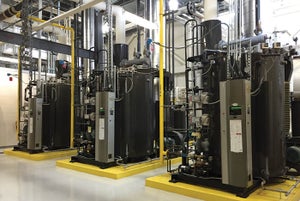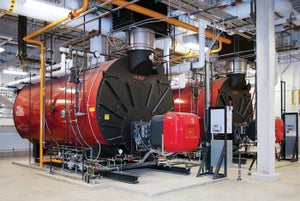Boiler and chiller options for hospital applications
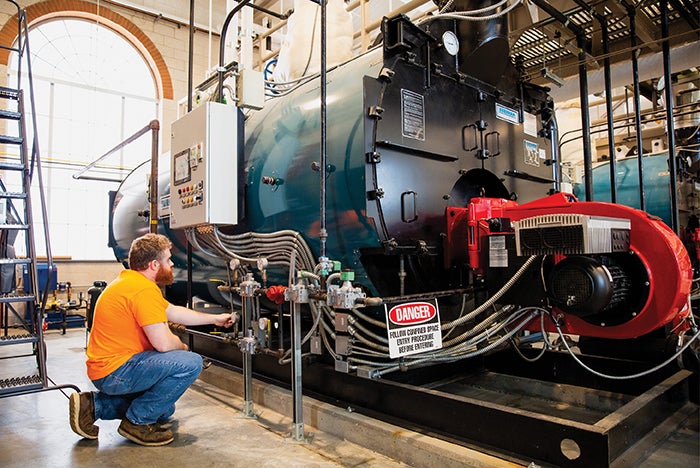
Image courtesy of Bradley Company
Boiler and chiller equipment manufacturers are focusing on sustainability, reliability, flexibility and technology to address the rigorous demands of hospitals and other health care facilities.
From fuel-efficient boilers with simplified operation to energy-conserving chillers with advanced control systems, these products are offering a variety of new features to provide essential heating and cooling functions.
Boiler benefits
One of the biggest issues for boiler manufacturers is adapting to hospitals’ sustainability goals, according to Josh Brown, a marketing communications official at Miura America Co. in Rockmark, Ga. “It’s important for boiler manufacturers to provide compact, energy-efficient solutions. Another issue is the ability to provide a dual-fuel option because [hospitals] must always be up and running,” he says.
Redundancy of equipment and power sources ensures consistent operation, adds David DeVries, director of product management at Weil-McLain in Burr Ridge, Ill. “Hospitals are evaluating how heat pump technology will fit relative to their heating systems’ redundancy and dual-fuel source capabilities,” he says.
Superior Boiler in Hutchinson, Kan., has introduced the Cheyenne condensing boiler, which addresses many of the limitations of steam systems, according to Trent Thurston, product engineering manager for condensing boilers. “Condensing boilers utilize hot water and extract as much heat as possible from the combustion process,” he says. “The result is higher efficiency, often reaching above 90%, compared to the 70% to 80% efficiency typical of steam boilers.” The Cheyenne offers efficiencies up to 95% during full fire, 99% during low fire and 91% to 92% in typical operations.
Weil-McLain offers the stainless vertical firetube boiler, available in seven sizes ranging from 500 thousand British thermal units per hour (MBH) to 3,000 MBH. It features a stainless-steel, vertical firetube and shell heat exchanger design for corrosion resistance, along with intuitive control systems. “The color touchscreen Unity 2.0 and Nuro controls are included as standard, enabling advanced diagnostic and troubleshooting, along with remote monitoring capabilities,” DeVries says.
Cleaver-Brooks in Thomasville, Ga., offers the SwitchFire large-capacity condensing boiler with No. 2 fuel oil backup. Suited for applications that require dual-fuel capabilities, it utilizes a burner that operates with low excess-air levels, which improves condensing performance, according to Sean Lobdell, vice president of sales for packaged boilers. “Also, its dual-return design improves boiler efficiency when compared to a single-return system. The SwitchFire is available in capacities from 6,000 MBH to 12,000 MBH and is Air Conditioning, Heating, and Refrigeration Institute-certified at 95.9% combustion efficiency and 98.5% thermal efficiency,” he says.
Cleaver-Brooks also offers the CBEX-3W firetube boiler, which achieves an operating efficiency of 85% on natural gas and 88% on No. 2 oil, Lobdell adds. “Its design combines EX technology with components such as a large furnace, advanced heat transfer tubes and an integral burner. The burner enables the boiler to attain 10:1 turndown while maintaining 3% excess oxygen across the full operating range,” he explains.
Aerco in Blauvelt, N.Y., offers the Benchmark E, a zero-emissions electric boiler that delivers energy-efficient, reliable heat in a compact, lightweight footprint, according to Nicholas Lane, product manager. It enables hospitals to effectively meet local regulations and codes regarding building electrification and decarbonization and is available in five sizes from 216 kilowatts (kW) to 684 kW, equivalent to approximately 750 MBH to 2,500 MBH output.
Benchmark E boilers come standard with Aerco’s Boiler Sequencing Technology (BST), which enables the load to be shared between up to 16 boiler units to maximize efficiency. As individual boilers are added or taken offline for maintenance, the energy delivered is automatically adjusted to prevent fluctuations in the header temperature of the plant. “In Spring 2025, BST will enable Benchmark E boilers to be sequenced with Aerco’s gas-fired boilers for a robust hybrid plant to optimize boiler operation and provide a secondary fuel source,” Lane says.
Miura America Co. recently introduced updated remote boiler room monitoring technology, called Miura Connect 2.0, which allows facilities managers to monitor multiple boiler rooms from their computer or smartphone. Miura Connect 2.0 sends immediate text alerts if a boiler goes down or needs repair. The company also offers the EX Series steam boilers, with gas and oil fuel options, which are suitable for health care facilities that need a secondary fuel source. “These boilers go from a cold start to full steam output in less than five minutes, consuming less fuel and boiler water and reducing emissions,” Brown says.
Burnham Commercial Boilers in Lancaster, Pa., offers the Commercial Firetube Boiler 4SP-500, which recently was installed in a Connecticut hospital. It produces at high efficiency due to a large furnace and high heat transfer design. The 4SP-500 also is a good option for low nitrogen oxide applications, according to Dan Rettig, product manager. “Hospitals will continue to move toward high-efficiency boilers for comfort heating and reheat applications, and they will require steam boilers for their sanitation needs. The move toward high efficiency and the need for steam will have manufacturers looking for the best way to provide a cost effective and reliable solution for hospitals in the future,” he says.
Chiller choices
Interruptions in cooling can pose significant risks in health care facilities. Thus, the primary challenge is to design and build chillers that can maximize uptime and provide continuous, reliable cooling, which is critical for patient care, equipment operation and sanitation, and overall safety, according to Art Rizoli, senior director of chiller product strategy at Daikin Applied in Minneapolis. “Finding ways to erase or mitigate the impact of power outages is the key. Hospitals also require chillers that can manage varying loads, and these facilities benefit from systems that can deliver warm water to paired boilers,” he says.
Historically, chillers have played a large role in ensuring that hospitals maintain peak performance, but the tradeoff has been the use of fossil fuels, water storage and energy-intensive heating and cooling processes, notes Suzanne Rahall, industry director for health care at Johnson Controls in Milwaukee. “As the health care field continues to advance in its sustainability journey, electric heat pumps will provide a solution to enhance energy efficiency while delivering operational return on investment,” she says.
Daikin Applied recently expanded its line of Magnitude water-cooled centrifugal chillers. The new models (WME-C and WME-D) are oil-free, magnetic-bearing chillers that offer high-efficiency and integrated variable-frequency drive (VFD) technology. “VFD enables the chillers to reduce in-rush current, optimizing load control and maximizing overall performance and efficiency,” Rizoli says. All VFD chillers are offered with optional IEEE 519-compliant harmonic filtration as well, ensuring that extra harmonics are filtered to avoid damaging any critical equipment.
Both new models feature RapidRestore and RideThrough technology to ensure continuous operation. “With RapidRestore, Magnitude chillers can restart 20 seconds after power is restored and then restore 80% cooling load capacity in less than 75 seconds,” Rizoli says. “RideThrough, Daikin’s power-trip resilience technology, allows the chiller to maintain operation, even during power loss, for up to 17 seconds.”
Johnson Controls recently launched two York high-temperature heat pump chillers — models CYK-400 and YVWH-200 — designed to help hospitals move toward decarbonization while providing operational cost savings. “Hospitals have a high demand for heating and cooling,” Rahall says. “The new York water-to-water heat pumps provide heating and cooling functions simultaneously, replacing the traditional chiller and boiler system with a more sustainable solution that consumes less utility-purchased energy. York heat pumps utilize low global warming potential (GWP) refrigerants to further reduce their carbon footprint and help hospitals achieve their decarbonization goals,” she adds.
Danfoss Turbocor in Tallahassee, Fla., recently introduced the model TGS380 oil-free, magnetic-bearing compressor, with a nominal 110-ton capacity. The compressor offers an expanded operating map to support hospital needs in the areas of comfort cooling, air-cooled chillers in extreme ambient climates and water-to-water heat pumps for heat recovery, according to Eddie Rodriguez, senior product manager.
“The TGS380 gives hospitals the flexibility to use oil-free compressors in more applications while maintaining critical requirements to minimize downtime,” Rodriguez says. “As with all Danfoss Turbocor compressors, it uses oil-free magnetic bearings, offering zero performance degradation over their lifetime, fast restart after power outages, high reliability and reduced maintenance due to the elimination of the complex chiller oil management system.”
Multistack LLC, a Sparta, Wis.-based manufacturer of high-efficiency chillers, is focusing on using waste heat to create hot water without burning fossil fuels. To that end, the company has introduced multiple products that are designed to create hot water across a wide range of chiller sizes, compressor types and chiller configurations. “Specifically, we have created heat recovery chillers that utilize magnetic compressor technology (MagLev), which ensures energy efficiency and reliability while providing virtually free hot water,” says Scott DeGier, vice president of sales. “MagLev compressors allow turndown while under load, providing better capacity control and temperature control as well as longer compressor life.”
Trane by Trane Technologies in Davidson, N.C., has introduced thermal battery storage-source heat pump systems that leverage the flexibility, sustainability and energy cost mitigation of thermal energy storage and apply those benefits to heating. “Heat pump systems extract renewable heat from the [air, ground or water] and use it to provide heating and hot water,” says Christy Fetsch, CEM, LEED AP, health care vertical market strategy leader.
“Heat pumps are highly efficient and can produce multiple units of heat for every unit of electricity consumed,” Fetsch says. “They can be used in combination with boilers for hybrid heating systems, further helping to reduce carbon emissions. While chillers are known for cooling, they also can provide heating by configuring them with heat recovery or heat pumps. Heat recovery is a good first step to electrification.” She adds that thermal energy storage expands the amount of recoverable waste heat from the cooling process for building heating, which is energy efficient.
To expand heating capacity beyond what can be recovered from the cooling process, Trane also offers reversible heat pumps, Fetsch notes. A reversible heat pump changes the roles of the evaporator and condenser by using a reversing valve inside the unit. Either cooling or heating may be the primary duty, depending on the operating mode and application.
Tecogen in Billerica, Mass., has introduced a hybrid chiller that allows hospitals to keep their chillers running even if the grid is in blackout, if a component needs maintenance, or if they want to change the driving fuel based on carbon emission or utility-saving goals. “We utilize the same engine technology as our other products, creating a high-efficiency combined heat and power system when using the engine to power the chiller,” says Dalton Allaben, sales engineer. “Also, we can pull power from the grid to power the chiller. Thus, hospitals can utilize one or both fuel sources, depending on variables such as the grid fuel mix, time-of-day electric rates and maintenance requirements.”
Looking ahead
In the future, hospital boilers and chillers will be more compact and occupy less space, equipment manufacturers say. They also will exhibit improved efficiency with advanced materials, enhanced heat transfer technology and optimized design. In addition, there will be growing demand for hospital chillers that utilize sustainable refrigerants with lower GWP and reduced environmental impact.

EXCELLENT EFFICIENCY
The Commercial Firetube Boiler 4SP-500 produces at high efficiency due to a large furnace and high heat transfer design. Burnham Commercial Boilers

OPTIMAL OPERATIONS
This stainless vertical firetube boiler has a thermal efficiency up to 96.8%, which contributes to lower operating costs. Weil-McLain
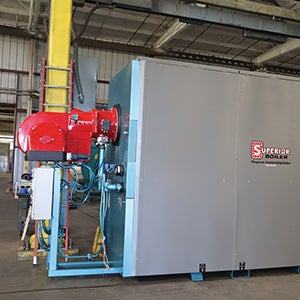
HOT TIME
The Cheyenne condensing boiler is designed to extract as much heat as possible from the combustion process. Superior Boiler
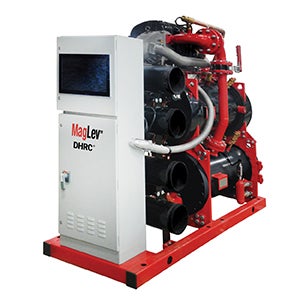
EVER READY
Heat recovery chillers utilize magnetic compressor technology, which ensures energy efficiency and reliability. Multistack LLC
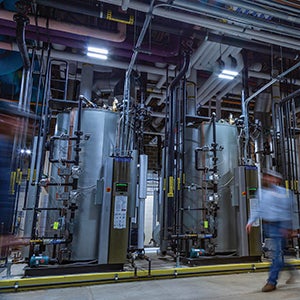
SWITCH UP
The EX Series dual-fuel steam boiler can quickly switch between No. 2 oil and natural gas/propane during fuel curtailment. Miura America Co
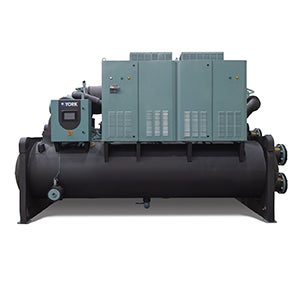
ENERGY UPGRADE
The York YVWH screw heat pump features variable-speed drive and efficient turndown load to enhance energy efficiency. Johnson Controls
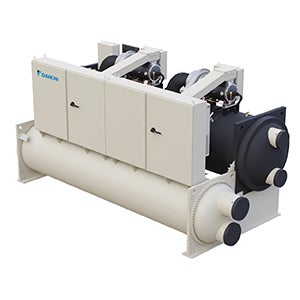
SPECIAL DELIVERY
The Magnitude WME-C chiller helps deliver quality air and precise humidity control while maximizing uptime and energy efficiency. Daikin Applied

FAST ACTION
The Turbocor TGS380 compressor uses oil-free, magnetic-bearing technology to provide fast restart after power outages and reduced maintenance. Danfoss Turbocor
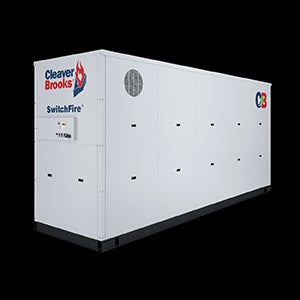
RUNNING RELIABLY
The SwitchFire large-capacity condensing boiler with oil backup ensures reliability and uninterruptable operation of a hospital’s heating system. Cleaver Brooks
Neal Lorenzi is a Mundelein, Ill.-based contributor to Health Facilities Management.



